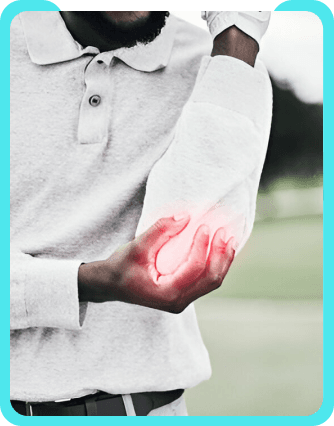

Golfer’s Elbow
What is Golf Elbow and How Can it be Treated?
An ailment known to affect professional athletes and active adults alike, golf elbow is one of the many conditions which we at Alleviate treat. Also known as medial epicondylitis, this ailment occurs when excessive strain or repetitive motions causes tendon connected to the medial epicondyle to become inflamed
These tendons run between the wrist and the medial epicondyle (the inner side of the elbow). This inflammation is worsened by wrist and arm motion and can lead to tenderness or pain due to motion. Treatment options for medial epicondylitis include rest, massage, steroid injection, and physical therapy. Surgery may be required in certain cases as well.
Alleviate, the premiere center for pain management in Bangalore, provides relief for thousands of patiennts. From minor pain to sports injuries and degenerative diseases, our team takes pride in providing treatment for whatever may be affecting our patients.
Treatment for Golfer’s Elbow


Video Spotlight
Blog
Surgery-Free Solutions
Expert Tips for Pain Management
Testimonials
Words From Our Patients
The treatment was very good and the doctor Faraz Ahmed was very kind to the patient and explained clearly the procedure of knee bilateral ha & botox And we were advised to do physiotherapy. We are very much satisfied. We would recommend this alleviate pain clinic.Thank you
Got treatment of Botox and HA for right knee arthritis a month ago and finding good relief from pain. Was treated by Dr Swagtesh Bastia who explained very well about the injections and the treatment was painless. The front desk staff were very kind and very helpful and physiotherapy was also done expertly, overall good experience
Alleviate Pain Management clinic has been a godsend for my mom's knee pain. She has been treated by Dr. Wiquar Ahmed. The attentive staff provided personalised care, and after her treatment, she's feeling remarkably better. Thank you for giving my mom the relief she deserves!
The clinic is super clean with a great OT and most importantly all the staff here are very helpful and considerate. My gratitude to Dr Roshan, the nurses, and support staff - they were always available to assist with any issues post procedure and they even made an extra effort to make a home visit for a follow up check-up. This team here is the perfect example of healing and care with a human touch. Thank you!!!!!
My wife had knee pain I have visited alleviate pain and consulted doc santhoshi now she is able to walk pain free and can do her daily activity than before.the physiotherapist here Dr akhila also helped her with few exercises and the staff here Abdul explained all the procedures well . Thank you PPL can visit here for pain relief





